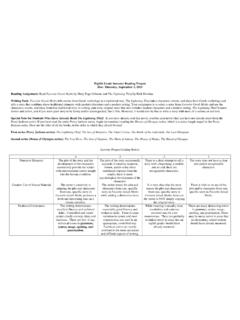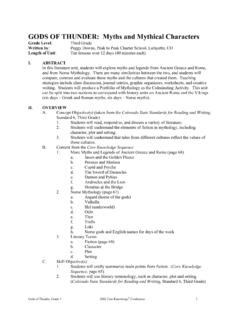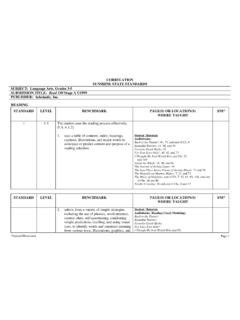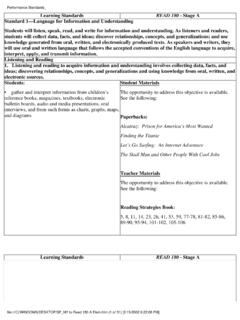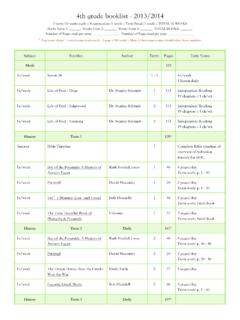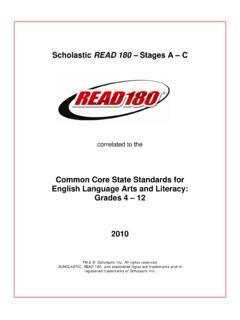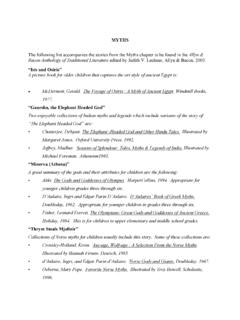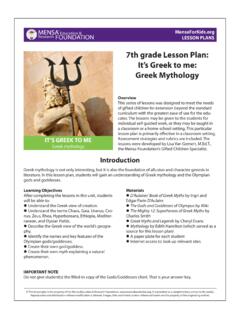Transcription of CLIMBING TO THE TOP OF MOUNT OLYMPUS
1 March 12-14, 1998 CLIMBING TO THE TOP OF MOUNT OLYMPUSG rade Level: Sixth Grade Presented by: Melanie Karp and Michelle Ventura, Vineyard Elementary School,Templeton CA Length of Unit: Nine Lessons I. ABSTRACT This unit has been designed to enhance students' awareness of Western culture inrelationship to its parent greek culture. greek mythology contains the seeds of basicquestions that Western civilization has been posing for more than 2500 years. Thelessons provide an opportunity for students to examine the origins of some of theseideas and to investigate the challenges that emerge from the myths . This unit can beadapted to the needs of all students. The fantasy element allows a flexible approach tolearning. Through a variety of multidisciplinary activities, students' imaginations will beengaged in age old questions still relevant today.
2 II. OVERVIEW A. The sixth grade Core Knowledge Sequence includes an introduction to classicalmythology. In connection with their study of lasting ideas from ancient Greece andRome history, the students will be able to identify with several gods and goddesses andtheir origins. B. The students will be able to identify greek influence on modern society. 1. Students will be able to locate Greece and Rome on a world map. 2. Students will be able to match mythical characters to what they represent. 3. Students will be able to define "myth." 4. Students will be able to find evidence that greek mythology has influenced modernsociety. 5. Students will be able to explain how the greek gods were named. 6. Students will create their own lyrical poem. 7. Students will create commercials to show how companies use Narcissism to sell theirproducts.
3 8. Students will create a newspaper based on their favorite myth and write anadvertisement to encourage others to read it. 9. Students will create a mythical figure from sculpting clay. 10. Students will participate in a mock Olympics. III. BACKGROUND KNOWLEDGE A. Hirsch, , What Your Sixth Grader Needs to Know. ISBN 0-385-41120-0. NewYork, , Doubleday Dell Publishing Group. Inc. 1993 B. Nash, Gary and Christopher Salter, A Message of Ancient Days, ISBN 0-395-54027-5. Boston, MA, Houghton Mifflin Company, 1991 IV. RESOURCES A. Books 1. D'Aulaire, Edgar and Ingri, D'Aulaire's Book of greek myths . ISBN: 0-385-01583-6,Doubleday and Company, Inc. 1962 2. Evans, Cheryl and Anne Millard, greek myths and Legends. ISBN: 0860209466,Usborne Publishing Ltd., 1985 3.
4 Evslin, Evslin and Hoopes, The greek Gods. ISBN: 0-590-43351-2, Scholastic Inc.,1966 4. Hadley, Eric and Tessa, Legends of the Sun and Moon. ISBN: 0-521-379121,Cambridge University Press, 1989. 5. Harrison, James C., Hooked on Fitness! ISBN: 0-13-065616-X, Parker PublishingCompany, West Nyack, , 1993 6. King, David c., Cultures. ISBN: 0-278-40228-3. American Book Company,Copyright 1979 by Litton Educational Company. 7. Lipson, Greta and Sidney Bolsky, Mighty Myth. ISBN: 0-86653-064-9, Good Apple,Inc. 1982 8. McLean, Mollie and Anne Wiseman, Adventures of the greek Heroes. ISBN: 0-395-13714-4. Houghton Mifflin Co., 1989 9. McLeish, Kenneth, The Seven Wonders of the World. ISBN: 0-521-379-113,Cambridge University Press, 1989. 10. Osborne, Mary Pope, favorite greek myths .
5 ISBN: 0-590-41339-2, Scholastic Inc.,1989. 11. Richardson, I. M. Odysseus and the Cyclops. ISBN: 0-8167-0008-7, TrollAssociates, 1984. V. LESSONS A. Lesson One: Where in the World Are Greece and Rome? 1. Objective/Goal: a. Students will be able to locate Greece and Rome on a world map. b. Students will be able to locate specific places using longitude and latitude. c. Students will gain an understanding of how these ancient places relate to the modernworld through the introduction to myths and legends. 2. Materials a. Overhead projector b. Overhead transparencies c. Overhead pens d. Individual maps for students e. World map f. Pencils for each student g. Map of Ancient Greece 3. Prior Knowledge for Students a. General knowledge of how to look at a map b.
6 Continents of the world c. Oceans of the world 4. Key Vocabulary a. continent b. longitude c. latitude d. city-state e. Odysseus f. peninsula g. democracy 5. Procedures/Activities a. Provide a bag of realia (articles from the greek /Roman culture). Pull out each itemand discuss its relevance to ancient history. b. Discuss with the class the growth of the greek city-states and the development ofdemocracy. c. Briefly describe the early masterpiece of greek literature, the Odyssey. (According tothe tale, Odysseus wandered for ten years among the islands and coastal regions ofwhat is now Greece.) d. Have students name the three seas that touch Greece (Aegean, Ionian, Mediterranean)Tell students that according to the Odyssey, Odysseus wandered throughout the regionknown as the Aegean Sea.
7 E. Have students use the information they've gained from the map to infer theimportance of the sea to the ancient people of Greece. f. At the time when Greece was home to powerful city-states, Rome was just a villageof straw-roofed huts. Rome was strongly influenced by greek culture. Within 600years, Rome had conquered Greece and much of the rest of the Mediterranean world. g. Read the legend of Romulus and Remus. Even though legends are not historicallyaccurate, Roman legends tell us qualities people admired and the values they wished topass on to future generations. h. Discuss the effect of the geography had on the birth of Rome (access to theMediterranean, protected location). I. Have students locate Greece and Rome on a map. j. Using lines of longitude and latitude, students will locate continents, oceans, Greeceand Rome.
8 K. Play "Battleship" giving degrees of longitude and latitude and cardinal directions tolocate certain places. 6. Evaluation/Assessment a. Students will be able to locate Greece and Rome on a world map. b. Students will be able to use lines of longitude and latitude to locate specific places ona map. c. Students will discover the importance of geography to the rise of a nation. B. Lesson Two: greek Mythology's Influence on the World's Culture 1. Objective/Goal: a. Students will understand why myths were created. b. Students will be able to define "myth." 2. Materials a. Soundtrack from "Hercules" b. Chart paper with mythical characters and what they represent c. Markers d. Journal for each child (See Appendix A for cover idea) e. Pencil for each child f.
9 Sponge or nerf ball 3. Prior Knowledge for Students Students should have had some knowledge of tall tales, fairytales, legends, myths , etc. 4. Key Vocabulary myth 5. Procedures/Activities a. Play music from "Hercules" soundtrack as students enter the room. b. The teacher will ask a probing question about the creation of the earth, such as "Howdid the stars get into the sky?" or "Why are some places on earth dry and frozen partswhile others are green and warm?" c. Students will discuss their thoughts in answer to the probing questions. d. Teacher will lead discussion detailing the following ideas: Over 2000 years agopeople did not always understand the wonders of nature. They reasoned thatsuperhuman powers that must be responsible and to describe the creation of naturalphenomenon.
10 And they intertwined these myths with moral values. e. Students will match mythical characters to what they represent on the class chart. f. Students will choose a name good or goddess name for themselves and a particularthing in nature that they represent and create a nametag. g. Form a circle and throw a nerf ball from one side of the circle to the other calling outthe student's mythical names. The ball will circulate until all student's names have beencalled. h. Ask students, "How has greek mythology influenced modern society?" 6. Evaluation/Assessment a. Students will match mythical characters to what they represent. b. Journal writing to describe "What is a myth?" c. Students will find evidence of the greek 's influence in advertisements andcommercials.








